读书笔记之:C++标准库扩展权威指南
这本书主要介绍的是C++标准的TR1库。对相关的库都进行了介绍。类似一个参考手册。
前言
C++ TR1库简介
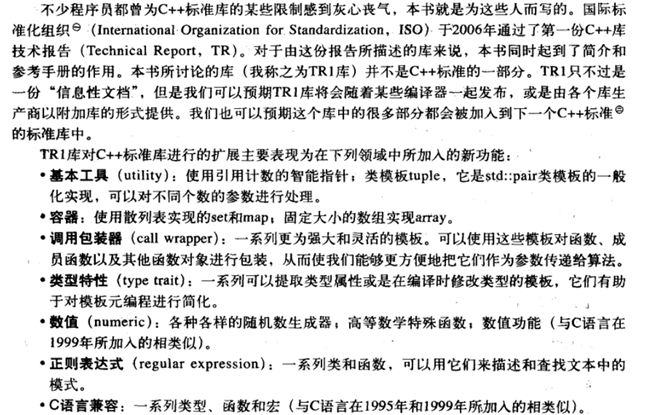
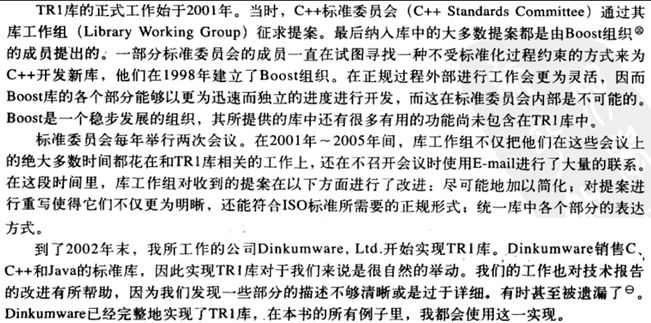
-
元组tuple
-
元组的tuple的声明
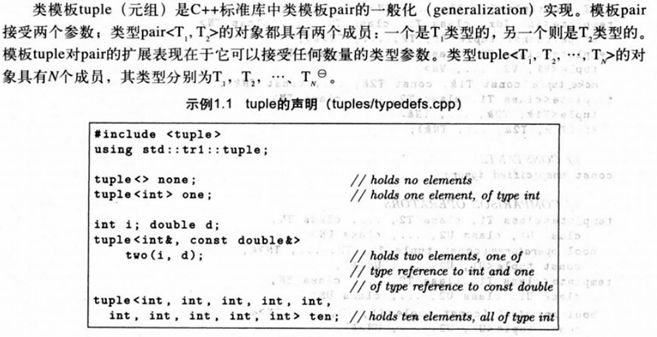
2. 创建tuple对象
使用make_tuple函数来创建tuple对象,但是make_tuple并不区分对象和对象的引用,两者都会得到和对象相同 类型的成员。
TR1库中的函数模板ref和cref可以创建包含引用的tuple对象。在头文件<functional>中定义。cref告诉make_tuple所要创建的成员是对常量类型的引用。
函数模板tie可以创建tuple对象包含对参数的引用。
程序代码:make_tuple.cc
 View Code
View Code
#include <typeinfo>
#include <tr1/tuple>
#include <tr1/functional>
using std::tr1::tuple;
using std::tr1::make_tuple;
using std::tr1:: ref;
using std::tr1::cref;
using std::tr1::tie;
using std::tr1::ignore;
using std::cout;
using std::endl;
template < class T>
void show_type(T){
cout<<typeid(T).name()<<endl;
}
void test1(){
int i= 3;
int& j=i;
show_type(make_tuple());
show_type(make_tuple( 1, 3.14));
show_type(make_tuple(i,j));
}
void test2(){
int i= 17;
int j= 3;
show_type(make_tuple( ref(i),cref(j)));
}
void test3(){
int i= 1;
int j= 23;
int k=- 4;
cout<<i<< ' '<<j<< ' '<<k<<endl;
tuple< int, int, int> mytuple;
mytuple=make_tuple( 5, 6, 7);
show_type(mytuple);
tie(i,ignore,k)=mytuple;
cout<<i<< ' '<<j<< ' '<<k<<endl;
show_type(tie(i,ignore,k));
}
int main(){
test3();
return 0;
}
3. tuple的存取

函数模板get

程序代码:assign.cc
 View Code
View Code
#include <utility>
#include <tr1/tuple>
using namespace std;
using namespace std::tr1;
void show( int i, int j, const tuple< int, int&, int>& t){
cout<<i<< ' '<<j<< " : "
<< get< 0>(t)<< ' '
<< get< 1>(t)<< ' '
<< get< 2>(t)<< ' \n ';
}
void show( const tuple< int, int>& t){
cout<< get< 0>(t)<< ' '
<< get< 1>(t)<< ' \n ';
}
void test1(){
int i= 1,j= 2;
tuple< int, int&, int> t0(i,j, 3);
tuple< int, double, char> t1( 4, 5.1, ' \6 ');
show(i,j,t0);
t0=t1;
show(i,j,t0);
tuple< int, int> t2( 1, 2);
show(t2);
t2=make_pair( 3, 4);
show(t2);
}
void test2(){
int i= 1,j= 2;
tuple< int, int&, int> t0(i,j, 3);
show(i,j,t0);
get< 0>(t0)= 4;
get< 1>(t0)= 5.1;
get< 2>(t0)= ' \6 ';
show(i,j,t0);
}
int main(){
test2();
return 0;
}
4. 类型查询
当需要知道某个tuple包含了多少元素时,可以使用类模板tuple_size
tuple_element获得元素类型

tuple:http://www.cplusplus.com/reference/std/tuple/tuple/
第2章 智能指针
1. shared_ptr和weak_ptr
这两个没有加入到C++11标准中去。
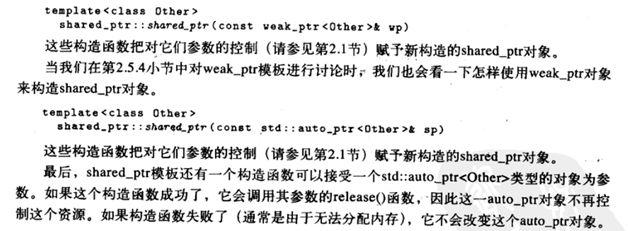

shared_ptr类模板
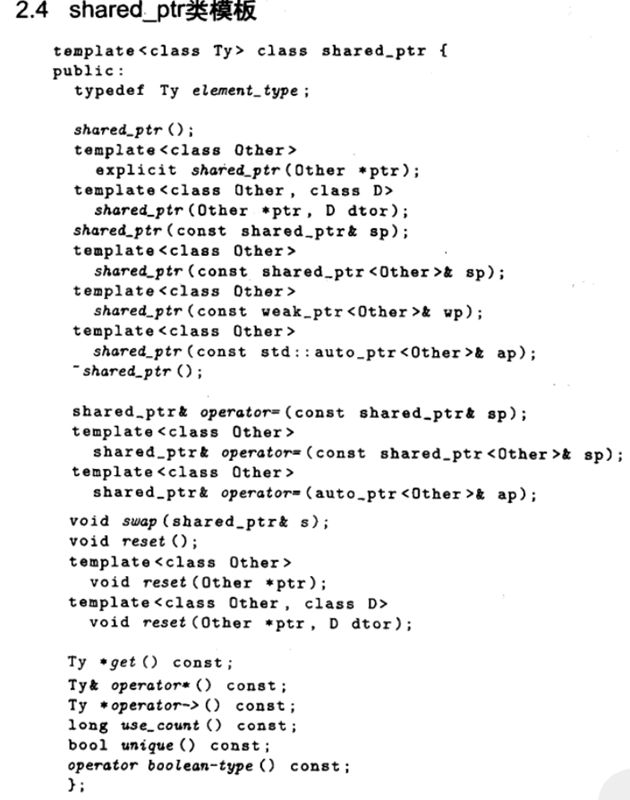
weak_ptr类模板

程序源码:
shared_ptr.cc
 View Code
View Code
#include <iostream>
using namespace std;
using namespace tr1;
void test1(){
int *ip= new int( 3);
cout<<( void*)ip<<endl;
shared_ptr< int> sp(ip);
cout<<( void*)sp. get()<<endl;
cout<<*sp<<endl;
cout<<( void*)&*sp<<endl;
}
void test2(){
shared_ptr< int> sp0;
cout<< " empty object: "<<sp0.use_count()<< " "<<sp0.unique()<<endl;
shared_ptr< int> sp1(( int*) 0);
cout<< " null pointer: "<<sp1.use_count()<< " "<<sp1.unique()<<endl;
shared_ptr< int> sp2( new int);
cout<< " one object: "<<sp2.use_count()<< " "<<sp2.unique()<<endl;
{
shared_ptr< int> sp3(sp2);
cout<< " two object: "<<sp3.use_count()<< " "<<sp2.unique()<<endl;
}
cout<< " one object: "<<sp2.use_count()<< " "<<sp2.unique()<<endl;
}
int main(){
test2();
return 0;
}
第3章 容器基础知识

第4章 类模板array
array已经加入到C++11中:http://www.cplusplus.com/reference/stl/array/
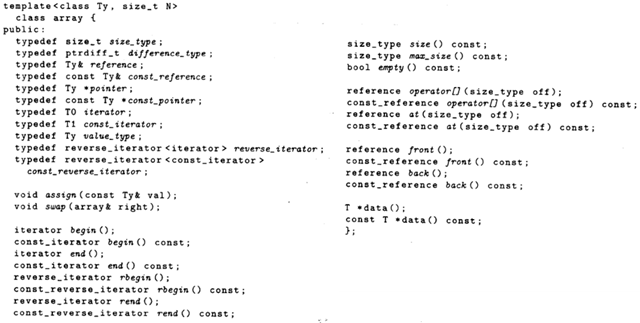

tr1同时为array提供了一些全局的函数
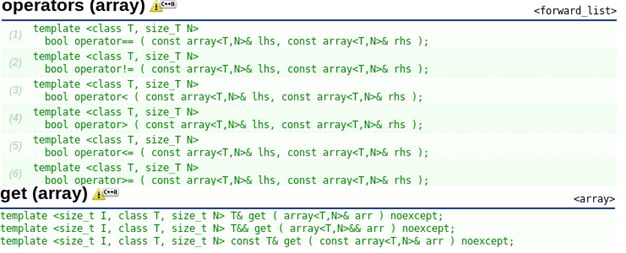
程序源代码:
array.cc
 View Code
View Code
#include <algorithm>
#include <iostream>
#include <iterator>
using namespace std;
using namespace std::tr1;
class elt{
friend ostream& operator<<(ostream& , const elt&);
public:
elt():i( 1){}
elt( int ii):i(ii){}
private:
int i;
};
ostream& operator<<(ostream& out, const elt& el){
out<<el.i<< ' ';
return out;
}
void test1(){
array<elt, 6> arr0;
copy(arr0.begin(),arr0.end(),ostream_iterator<elt>(cout, " "));
cout<<endl;
array<elt, 6> arr1={ 1, 2, 3, 4};
copy(arr1.begin(),arr1.end(),ostream_iterator<elt>(cout, " "));
cout<<endl;
array< int, 6> arr2={ 1, 2, 3, 4};
copy(arr2.begin(),arr2.end(),ostream_iterator< int>(cout, " "));
cout<<endl;
array< int, 6> arr3;
copy(arr3.begin(),arr3.end(),ostream_iterator< int>(cout, " "));
cout<<endl;
array< int, 6> arr4={};
copy(arr4.begin(),arr4.end(),ostream_iterator< int>(cout, " "));
cout<<endl;
array< int, 6> arr5=arr2;
copy(arr5.begin(),arr5.end(),ostream_iterator< int>(cout, " "));
cout<<endl;
}
int main(){
test1();
}
第5章 无序关系容器
这儿其实就是sgiSTL中所实现的散列表。
已经加入到C++11中:
unordered_map:http://www.cplusplus.com/reference/stl/unordered_map/
unordered_multimap:http://www.cplusplus.com/reference/stl/unordered_multimap/
unordered_multiset:http://www.cplusplus.com/reference/stl/unordered_multiset/
set: http://www.cplusplus.com/reference/stl/unordered_set/
关系容器与无序容器
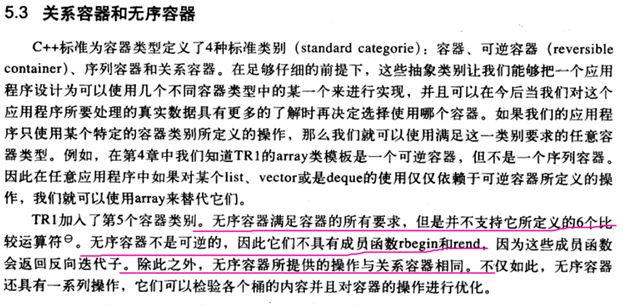
hash函数
程序hash.cc
 View Code
View Code
#include <iostream>
#include < string>
#include <vector>
#include <iterator>
using namespace std;
using namespace std::tr1;
template < class T>
void show_hashes(T first,T last){
typedef typename iterator_traits<T>::value_type type;
hash<type> hasher;
while(first!=last){
cout<<hasher(*first++)<< ' ';
}
cout<<endl;
}
struct coord{
int x,y;
};
namespace std{
namespace tr1{
template <>
struct hash<coord>{
std::size_t operator()( const coord& val) const{
hash< int> make_hash;
return make_hash(val.x)+make_hash(val.y);
}
};
}
}
int test1(){
int data[]={ 1, 2, 3, 4, 5, 6};
show_hashes(data,data+ 6);
char* text[]={ " 1 ", " 2 ", " 3 ", " 4 ", " 5 "};
vector< string> strs(text,text+ 5);
show_hashes(strs.begin(),strs.end());
coord points[]={{ 0, 0},{ 0, 1},{ 1, 0},{ 1, 1},{ 2, 2}};
show_hashes(points,points+ 5);
return 0;
}
int main(){
test1();
}
第6章 调用包装器基础

第14章 正则表达式头文件<regex>
已经加入到标准中
basic_regex: http://www.cplusplus.com/reference/std/regex/basic_regex/
第15章 正则表达式语法
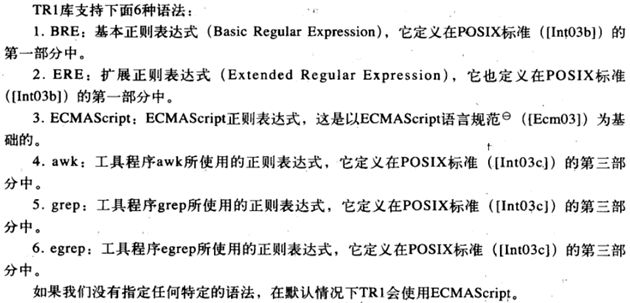
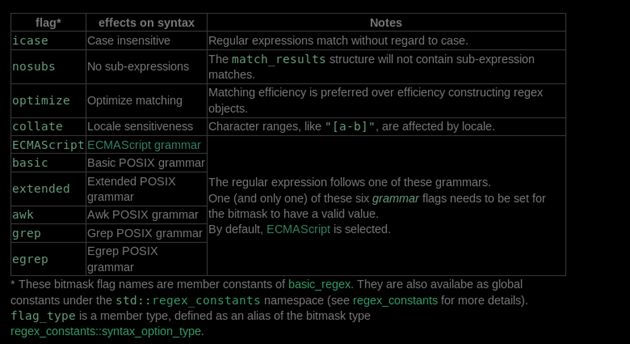
第22章 C语言兼容
